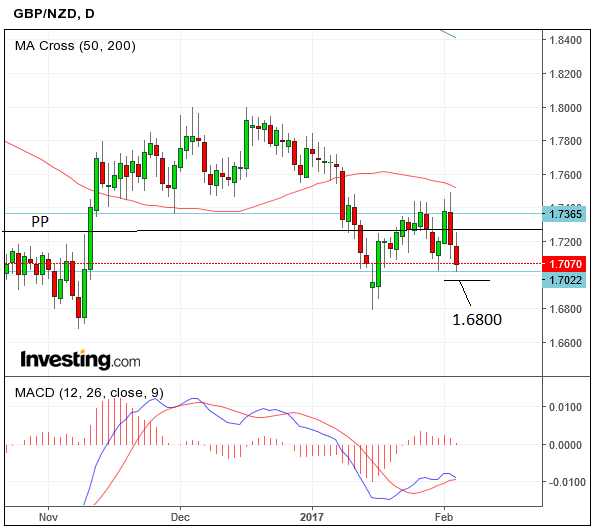The GBP/NZD Rate: Downside Bias Likely to Extend, RBNZ Decision, Brexit Debate in UK Parliament

Pound Sterling trades lower at the start of the new week at 1.7018 and looks set to test the bottom of its recent range.
GBP/NZD has embarked on a short-term downtrend after temporarily rising back up to 1.7400 before gains in Sterling were halted by the Bank of England who made it clear in an appearance on February 2nd that they are not looking to raise interest rates anytime soon.
There is a possibility the pair is entering a range-bound period of consolidation between the 1.70-1.74 corridor.
Evidence from the longer-term charts, however, presents a longer-term bearish bias so we would expect there to be a greater probability of an eventual break lower once the sideways range has finished.
A move below 1.6950 would probably confirm such a move, with the early January lows at 1.6800 presenting a natural target.
Q1 Effect to Weaken NZD
The NZD is outperforming nearly every other currency worldwide, up 5% against USD since January 1.
However, we are alerted to suggestions that February could be a poor month for the currency.
Research from RBC Capital markets shows a Q1 cyclical effect for the commodity currencies, but especially NZD.
The effect is likely to see NZD weaken during the rest of the first quarter.
As we go into February, RBC Capital are looking for the NZ Dollar's outperformance to reverse.
"There is good historical evidence that January moves in commodity currencies tend to reverse through February/March. NZD, in particular, reverses its January direction more than 70% of the time,” adds RBC’s Elsa Lignos.
RBNZ Meeting is Key Event for NZD this Week
The main event this week is the Reserve Bank of New Zealand (RBNZ) who release the results of their first iMonetary Policy Statement for the year on Wednesday, February 8 at 19.00 GMT.
No change in the 1.75% policy rate is expected.
Consensus estimates see the interest rate remaining at 1.75%.
However, a dovish statement could prompt the NZD lower given strong recent data flow.
At its last interest rate decision in November, the RBNZ cut the OCR to a record low of 1.75%.
At the same time, they adopted a neutral stance, signalling that they expected to keep the OCR at that low level for an extended period in order to support economic activity and generate a lift in domestic inflation.
Since then, we’ve seen headline inflation rise back into the RBNZ’s target band after lingering below 1% levels for the past two years.
However, it is worth noting that much of the pickup in inflation owes itself to the NZD's fall back in 2015, research by Westpac Bank suggests that it takes about a year for exchange rate effects to feed into prices.
The recovery of NZD through 2016 will therefore have a downward influence in prices going forward.
"The continued softness in imported prices means that in order to meet their inflation target, the RBNZ will need to see a lift in home-grown inflation," says Bill Evans, Chief Economist at Westpac. "But this may be easier said than done. It’s true that the economy has been growing at a rate of more than 3% per annum, and that sort of pace is expected to be sustained through the coming year."
Evans notes much of this growth is coming on the back of record net migration. The resulting increase in the population is adding to demand in the economy.
"At the same time, it is boosting our productive capacity, allowing the economy to grow without a significant lift in cost pressures. Adjusting for population growth, GDP is only growing at around 1% a year – a rate that’s just not that impressive by historic standards, and not really indicative of an economy that’s at risk of overheating," says Evans.
Westpac believe the RBNZ are to keep interest rates unchanged in 2017 as endorsing any hikes could push financial conditions in an undesired direction.
The event is therefore unlikely to prompt any notable strength in the NZD.
Expect a Weakening of the Pound
Despite the New Zealand Dollar unlikely to find any notable fundamental drivers in the near-term, when compared with Sterling we would note it benefits from political stability and strong economic growth.
The Pound weakened in early February after the Bank of England (BOE) revised up growth forecasts but kept inflation forecasts unchanged while communicating no interest rate rises are likely in the foreseeable future.
The Bank's projections, and the Pound's continued underperformance thanks to uncertainty concerning Brexit have kept - and are likely to keep - the Pound subdued.
“We confirm our expectations for a possible – albeit modest – weakening of the Pound in the near term, mostly due to the new phase of uncertainty that will begin once the Brexit process is officially triggered,” says Asmara Jamaleh, an analyst with Intessa Sanpaolo.
On this front, a three-day debate on a law giving May the right to trigger Britain's exit from the European Union begins on Monday, and will be followed by a series of votes on whether to attach extra conditions to her plan to start talks by March 31.
Important amendments to the Bill will be discussed during debates leading up to the vote on Wednesday, which could impact how ‘Hard’ or ‘Soft’ Brexit could be.
One proposed amendment would be to discuss whether the UK should exit the common market as well as the EU before withdrawing.
Another asks for Parliament to be regularly updated by the government on the, “advancement of the negotiations".
Parliament may ask for further powers, including the power to vote to approve the agreement after negotiations are completed with the EU - and to extend negotiations in order to reach a better agreement.
Then there may also be amendments to protect the right of EU citizens living in United Kingdom and the request for an assessment of the impact of Brexit on specific sectors, such as climate change, social inequality, and public finance.
Once the vote in the Commons is passed the House of Lords will have their turn to debate and vote on the Bill on February 20.
It is then expected to be implemented on March 7.
Keep an eye on headlines - if there are signs Parliament is gaining an upper hand, and winning concessions we believe it would be positive for Sterling and with the currency under so much pressure we would argue risks are to the upside
Data to Watch
From a data perspective, the big release will be Manufacturing and Industrial Production on Friday, February 10, at 9.30 GMT.
Analysts estimate a downtick to 0.4% from 1.3% previously for Manufacturing, and Industrial Production slowing to 0.2% from 2.1% in December.
The Trade Balance, also released on Friday is expected to show a narrowing of the Deficit to -11.4bn from -12.16bn in December.






